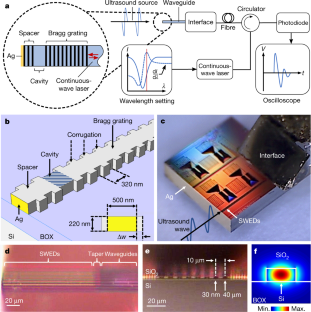(“Honey, I shrunk the detector”: Researchers have developed the world’s smallest ultrasound detector)
2020/9/16 ドイツ連邦共和国・ヘルマン・フォン・ヘルムホルツ協会(HGF)

・ HGF のヘルムホルツ・ツェントラム・ミュンヘン(HMGU)とミュンヘン工科大学(TUM)が、人間の毛髪の1/100 のサイズの世界最小の超音波検出器を開発。
・ 超音波からの圧力を電圧に変換する圧電検出器は、1950 年代の医療用超音波イメージングの開発以来、超音波の中核的な検出技術となっている。超音波による画像の解像度は圧電検出器のサイズに左右され、そのサイズの縮小でより高い解像度が得られ、識別能力により優れた小型の 1 次元または2 次元の高密度超音波アレイができるが、圧電検出器のサイズを縮小すると感度が大幅に損なわれ、実用に適さない。
・ 今回、シリコンフォトニクス技術の利用により、超音波の検出に血球よりも小さな検出器を実現。圧電検出器をこのようなスケールに微細化した場合、感度は 1 億分の 1 に低減する。
・ シリコンフォトニクス技術は、光学素子の微細化やシリコン基板の狭い面積での光学素子の高密度集積に利用されている。シリコンは圧電効果を持たないが、光の波長よりも小さな面積に光を閉じ込められるため、微細なフォトニック回路の開発で広範囲に利用されている。
・ 今回開発した世界最小の超音波検出器は、微細なフォトニック回路を活用したシリコン導波管-エタロン検出器(SWED)。圧電性結晶からの電圧を記録するのではなく、フォトニック回路を伝搬する光の強度の変化を SWED がモニタリングする。
・ SWED のサイズは約 0.5 ミクロン(=0.0005mm)で、最も小さな圧電検出器の最適でも 1/10000 の面積に相当する。また、使用する超音波の波長の 1/200 で、1 マイクロを下回るサイズの可視化も可能なため、超解像度イメージングが期待できる。
・ 同技術はシリコンプラットフォームの安定性と容易な製造性を活用するため、圧電検出器の一部の僅かなコストでの大量生産も可能。開発当初は臨床診断やバイオ医療研究での利用を想定したが、細胞組織や物質の超解像画像の研究等の産業用アプリケーションも見込む。
・ 今後も感度、大規模アレイへの SWED の集積、ポータブルデバイスや内視鏡での実用等、同技術の全要素について最適化を進める。
URL: https://www.helmholtz-muenchen.de/en/aktuelles/latest-news/press-informationnews/article/48828/index.html
<NEDO海外技術情報より>
(関連情報)
Nature 掲載論文(アブストラクトのみ:全文は有料)
A submicrometre silicon-on-insulator resonator for ultrasound detection
URL: https://www.nature.com/articles/s41586-020-2685-y
Abstract
Ultrasound detectors use high-frequency sound waves to image objects and measure distances, but the resolution of these readings is limited by the physical dimensions of the detecting element. Point-like broadband ultrasound detection can greatly increase the resolution of ultrasonography and optoacoustic (photoacoustic) imaging1,2, but current ultrasound detectors, such as those used for medical imaging, cannot be miniaturized sufficiently. Piezoelectric transducers lose sensitivity quadratically with size reduction3, and optical microring resonators4 and Fabry–Pérot etalons5 cannot adequately confine light to dimensions smaller than about 50 micrometres. Micromachining methods have been used to generate arrays of capacitive6 and piezoelectric7 transducers, but with bandwidths of only a few megahertz and dimensions exceeding 70 micrometres. Here we use the widely available silicon-on-insulator technology to develop a miniaturized ultrasound detector, with a sensing area of only 220 nanometres by 500 nanometres. The silicon-on-insulator-based optical resonator design provides per-area sensitivity that is 1,000 times higher than that of microring resonators and 100,000,000 times better than that of piezoelectric detectors. Our design also enables an ultrawide detection bandwidth, reaching 230 megahertz at −6 decibels. In addition to making the detectors suitable for manufacture in very dense arrays, we show that the submicrometre sensing area enables super-resolution detection and imaging performance. We demonstrate imaging of features 50 times smaller than the wavelength of ultrasound detected. Our detector enables ultra-miniaturization of ultrasound readings, enabling ultrasound imaging at a resolution comparable to that achieved with optical microscopy, and potentially enabling the development of very dense ultrasound arrays on a silicon chip.



